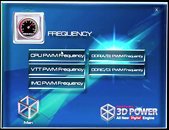Monday, November 7th 2011

Gigabyte Shows Off 3D Power Technology for Upcoming Motherboards
Last week we got a glimpse of Gigabyte's new 3D BIOS technology, a UEFI setup program with an innovative and functional user interface built into Gigabyte's upcoming X79 motherboards. Today Gigabyte released a new video detailing another such innovation, called 3D Power. This program gives you total and unrestricted control over the three main dimensions of your motherboard's power delivery: voltages, PWM frequency, and phase control. Gigabyte announced that all its upcoming X79 motherboards will feature PWM (pulse width modulation) CPU power design, backed by highly capable PWM controllers that give you a plethora of things you can tweak.
To begin with, the 3D Power application starts up with a cube that has the icons of the three main elements. Clicking on "voltage" gives you control over voltage-related settings in three main pages, turbo voltage response, load line calibration (active V-droop control), and active over-voltage protection. Load line calibration allows you to fine-tune the extant of V-droop correction over a variety of power domains, such as CPU, VTT, IMC, and DRAM.Moving on to Phase Control, and this page gives you settings related to the phases. You can select the number of CPU phases you want active (from the number available), and thereby balance efficiency and power delivery, to do this you can select between six phase-arrangement presets from "Lite Power" all the way up to "Extreme Performance". Then there are other pages that let you configure thermal protection.
Lastly there's frequency. Pulse width modulation is a method of controlling power-delivery by delivering power in pulses to inertial electrical devices. PWM frequency related pages give you access to some very low-level settings such as CPU, VTT, IMC, and DRAM PWM frequencies.
Unlike 3D BIOS, which resides on the motherboard's EEPROM and can be invoked by hitting DEL on system startup, 3D Power is a Windows-based application. One can expect most settings not to be on-the-fly, and requiring system restarts. A press video from Gigabyte can be watched here.
To begin with, the 3D Power application starts up with a cube that has the icons of the three main elements. Clicking on "voltage" gives you control over voltage-related settings in three main pages, turbo voltage response, load line calibration (active V-droop control), and active over-voltage protection. Load line calibration allows you to fine-tune the extant of V-droop correction over a variety of power domains, such as CPU, VTT, IMC, and DRAM.Moving on to Phase Control, and this page gives you settings related to the phases. You can select the number of CPU phases you want active (from the number available), and thereby balance efficiency and power delivery, to do this you can select between six phase-arrangement presets from "Lite Power" all the way up to "Extreme Performance". Then there are other pages that let you configure thermal protection.
Lastly there's frequency. Pulse width modulation is a method of controlling power-delivery by delivering power in pulses to inertial electrical devices. PWM frequency related pages give you access to some very low-level settings such as CPU, VTT, IMC, and DRAM PWM frequencies.
Unlike 3D BIOS, which resides on the motherboard's EEPROM and can be invoked by hitting DEL on system startup, 3D Power is a Windows-based application. One can expect most settings not to be on-the-fly, and requiring system restarts. A press video from Gigabyte can be watched here.





19 Comments on Gigabyte Shows Off 3D Power Technology for Upcoming Motherboards
looks like very marketing words.
We dont want a glorified easytune with humungous icons.
Just something to add, till now i had GB MSI and Asus 1155 mobos and just by looking at bioses i cannot understand why i used GB and MSI. How those manufactures are not emberassed by the lack of options in the bios? long live the ability (my ability) to achieve 5GHZ at 1.37V and not 1.42 or 1.43 volts.
if people haven't noticed or didn't hear the new flash, GIGABYTE has moved over to Digital PWMs, which offer MUCH MUCh more user tweaking in real-time and through BIOS. it is one of the greatest advantage of Digital PWm technology, as the PWM has on-board NVM. Now GB is using an un-released VRD12/12.5 Internation Rectifer Digital 8 phase PWM, its basically an upgraded Chil 8-Phase PMW you see on the Maximus 4 Extreme. ASUS for their X79 board has an updated Chil PWM the same technology and VRD12 and 12.5 cert as the one GB is using.
International Rectifier bought Chil about a year ago, and since then they have basically rebranded Chil PWMs with their own name. Selling the same product just a bit different. The ASUS is 7+1 phases and the GB is 6+2, both can have the capability for 8 phase operation.
Don't expect the Vdroop that was seen on the LGA1155 GB boards as GB has revamped their entire VRM.
#1 this in-windows utility is like Digi+ VRM utility ASUS has, its realtime VRM/PWM changes through windows. Without restart.
#2 all these settings are in the BIOS as well, you can see them in the 3D BIOS video.
Someone take the Dev's Sega Genesis away please..